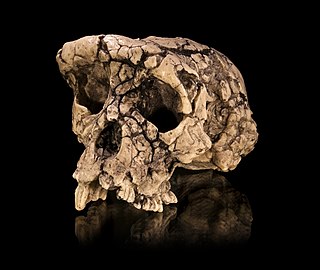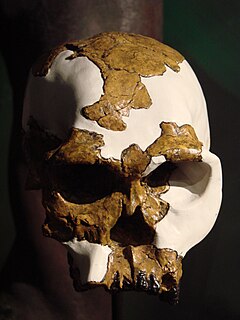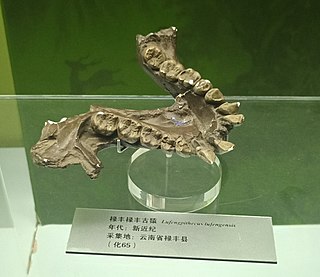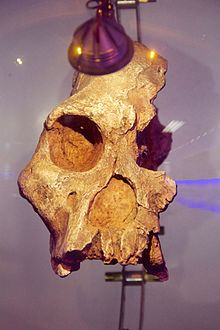
The Piltdown Man was a paleoanthropological fraud in which bone fragments were presented as the fossilised remains of a previously unknown early human. Although there were doubts about its authenticity virtually from the beginning, the remains were still broadly accepted for many years, and the falsity of the hoax was only definitively demonstrated in 1953. An extensive scientific review in 2016 established that amateur archaeologist Charles Dawson was responsible for the fraudulent evidence.

Australopithecus is a genus of early hominins that existed in Africa during the Late Pliocene and Early Pleistocene. The genera Homo emerged within Australopithecus, as sister to e.g. Australipitecus sediba. Also the genera Paranthropus, and Kenyanthropus emerged within the Australopithecus. Australopithecus is a member of the subtribe Australopithecina, which also includes Ardipithecus, though the term "australopithecine" is sometimes used to refer only to members of Australopithecus. Species include A. garhi, A. africanus, A. sediba, A. afarensis, A. anamensis, A. bahrelghazali and A. deyiremeda. Debate exists as to whether some Australopithecus species should be reclassified into new genera, or if Paranthropus and Kenyanthropus are synonymous with Australopithecus, in part because of the taxonomic inconsistency.

Sahelanthropus tchadensis is an extinct species of the Homininae dated to about 7 million years ago, during the Miocene epoch. The species, and its genus Sahelanthropus, was announced in 2002, based mainly on a partial cranium, nicknamed Toumaï, discovered in northern Chad.

Deinotherium was a large prehistoric relative of modern-day elephants that appeared in the Middle Miocene and survived until the Early Pleistocene. During that time, it changed very little. In life, it probably resembled modern elephants, except it had downward-curving tusks attached to the lower jaw.

Meganthropus is an extinct genus of non-hominin hominid ape, known from the Pleistocene of Indonesia. It is known from a series of large jaw and skull fragments found at the Sangiran site near Surakarta in Central Java, Indonesia, alongside several isolated teeth. The genus has a long and convoluted taxonomic history. The original fossils were ascribed to a new species, Meganthropus palaeojavanicus, and for a long time was considered invalid, with the genus name being used as an informal name for the fossils.

Thylacoleo is an extinct genus of carnivorous marsupials that lived in Australia from the late Pliocene to the late Pleistocene. Some of these marsupial lions were the largest mammalian predators in Australia of their time, with Thylacoleo carnifex approaching the weight of a lioness. The estimated average weight for the species ranges from 101 to 130 kg.

Mrs. Ples is the popular nickname for the most complete skull of an Australopithecus africanus ever found in South Africa. Many Australopithecus fossils have been found near Sterkfontein, about 40 kilometres (25 mi) northwest of Johannesburg, in a region of Gauteng now designated as the Cradle of Humankind World Heritage Site. Mrs. Ples was discovered by Robert Broom and John T. Robinson on April 18, 1947. Because of Broom's use of dynamite and pickaxe while excavating, Mrs. Ples's skull was blown into pieces and some fragments are missing. Nonetheless, Mrs./Mr. Ples is one of the most "perfect" pre-human skulls ever found. The skull is currently held at the Ditsong National Museum of Natural History in Pretoria.

Australopithecus africanus is an extinct species of australopithecine which lived from 3.67 to 2 million years ago in the Middle Pliocene to Early Pleistocene of South Africa. The species has been recovered from Taung and the Cradle of Humankind at Sterkfontein, Makapansgat, and Gladysvale. The first specimen, the Taung child, was described by anatomist Raymond Dart in 1924, and was the first early hominin found. However, its closer relations to humans than to other apes would not become widely accepted until the middle of the century because most had believed humans evolved outside of Africa principally due to the hoax transitional fossil Piltdown Man from Britain. It is unclear how A. africanus relates to other hominins, being variously placed as ancestral to Homo and Paranthropus, to just Paranthropus, or to just P. robustus. The specimen "Little Foot" is the most completely preserved early hominin, with 90% of the skeleton intact, and the oldest South African australopith. However, it is controversially suggested that it and similar specimens be split off into "A. prometheus".

Homo rhodesiensis is the species name proposed by Arthur Smith Woodward (1921) to classify Kabwe 1, a Middle Stone Age fossil recovered from a cave at Broken Hill, or Kabwe, Northern Rhodesia .. In 2020, the skull was dated to 324,000 to 274,000 years ago. Other similar older specimens also exist.

Australopithecus anamensis is a hominin species that lived approximately between 4.2 and 3.8 million years ago and is the oldest known Australopithecus species, living during the Plio-Pleistocene era.

The Taung Child is the fossilised skull of a young Australopithecus africanus. It was discovered in 1924 by quarrymen working for the Northern Lime Company in Taung, South Africa. Raymond Dart described it as a new species in the journal Nature in 1925.
The genus Apidium is that of at least three extinct primates living in the early Oligocene, from 30 to 28 million years ago. Apidium fossils are common in the Fayoum deposits of Egypt. Fossils of the earlier species, Apidium moustafai, are rare; fossils of the later species Apidium phiomense are fairly common.

STS 14 is a fossilized partial skeleton of the species Australopithecus africanus. It was discovered at Sterkfontein, South Africa by Robert Broom and John T. Robinson in August 1947, and is estimated to be about 2.5 million years old.

SK 46 is the fossilized partial cranium and palate of the species Paranthropus robustus. It was discovered in Swartkrans, South Africa by local quarrymen and Robert Broom in 1949.

OH 24 is a fossilized skull of the species Homo habilis. It was discovered in Olduvai Gorge, Tanzania by Peter Nzube in 1968. The skull was found crushed almost flat and was therefore named after the famously skinny model of the time Twiggy. Estimated at about 1.8 mya, the cranium was found crushed flat and cemented together with a mass coating of limestone.

KNM WT 17000 is a fossilized adult skull of the species Paranthropus aethiopicus. It was discovered in West Turkana, Kenya by Alan Walker in 1985. Estimated to be 2.5 million years old, it is an adult with an estimated cranial capacity of 410 cc.

Dali man is the remains of a late Homo erectus or archaic Homo sapiens who lived in the late-mid Pleistocene epoch. The remains comprise a complete fossilized skull, which was discovered by Liu Shuntang in 1978 in Dali County, Shaanxi Province, China.

Jebel Irhoud is an archaeological site located just north of the locality known as Tlet Ighoud, approximately 50 km (30 mi) south-east of the city of Safi in Morocco. It is noted for the hominin fossils that have been found there since the discovery of the site in 1960. Originally thought to be Neanderthals, the specimens have since been assigned to Homo sapiens or Homo helmei and, as reported in 2017, have been dated to roughly 300,000 years ago.

Lufengpithecus lufengensis is a prehistoric species of hominoid from the Late Miocene found in China, named after the Lufeng site and dated around 6.2 Ma. It is the latest Miocene fossil ape that has been discovered in the entire world. Some researchers believe that genus Lufengpithecus could be an ancestor to African apes and hominids.

The Cave of Aroeira is an archaeological and paleoanthropological site in the Portuguese Estremadura Limestone Massif. The cave is located in the village of Almonda, in the civil parish of Zibreira, in the municipality of Torres Novas in the district of Santarém. The cave contained stones from the Paleolithic Acheulean culture, and the skull of Homo heidelbergensis, circa 400,000 years old. The discovery of Aroeira 3 was announced in spring 2017 - the earliest human trace in Portugal.


















